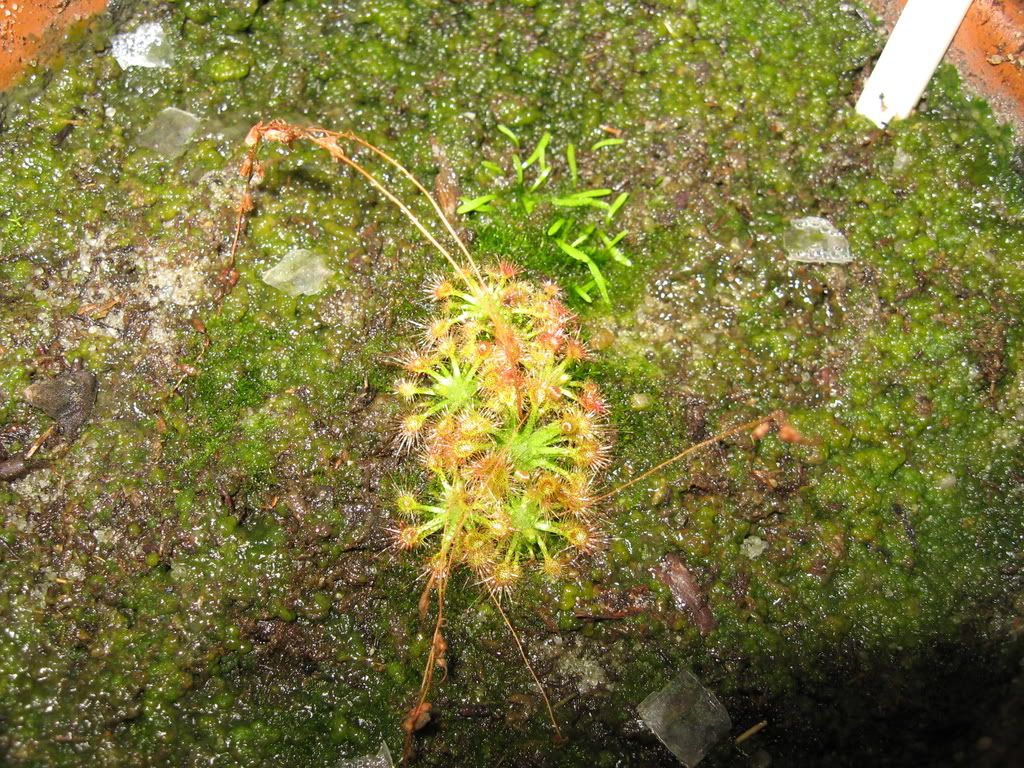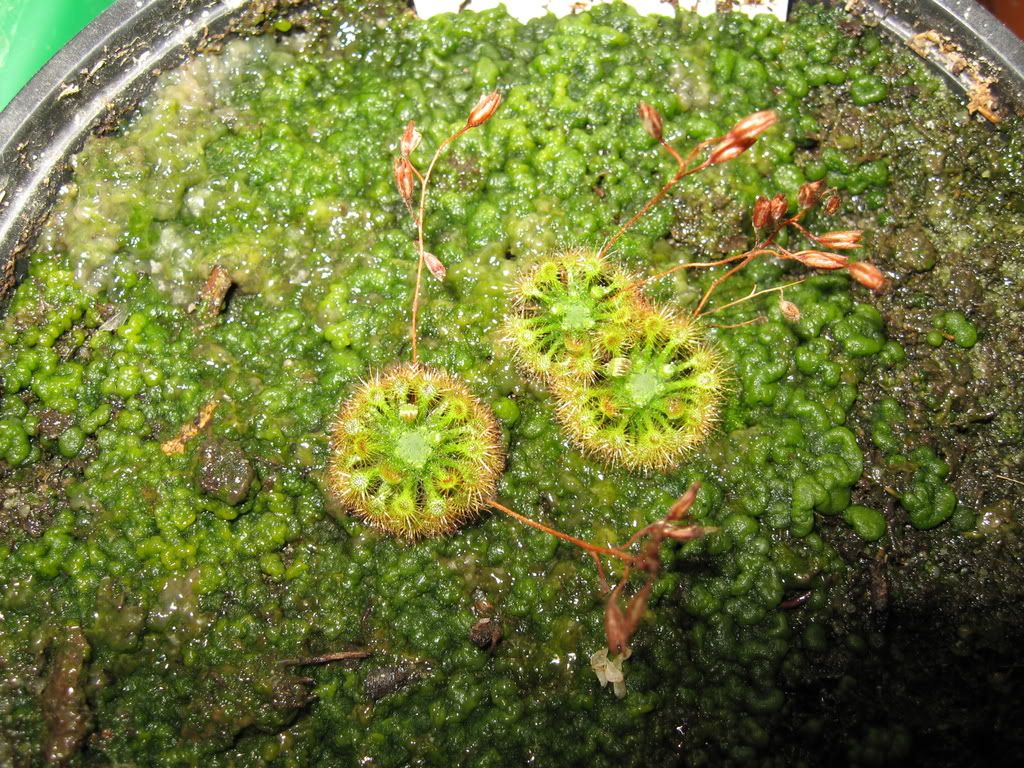|
|
Post by strath76 on Apr 8, 2008 6:04:52 GMT 8
Below is a couple of photos of my pygmy drosera.  Drosera spilos Drosera spilos Drosera nitidula Drosera nitidula |
|
|
|
Post by droserahybridman on Apr 9, 2008 9:51:45 GMT 8
hey,
nice growing. how old are those pygmies?
Also, what are those green leaf formations in the top picture?
Thanks
|
|
|
|
Post by strath76 on Apr 9, 2008 10:30:11 GMT 8
Thanks, I bought them about 3 months ago so I don't know the exact age. The leaves at the top I presume are a Utricularia. They came with the plants. I am waiting for a flower to ID them. Cheers.
|
|
|
|
Post by tarence on Apr 9, 2008 11:24:26 GMT 8
Strath: hey, your pygmies are flowering already ! mine are still growing.....i got them about 4 months ago....
|
|
|
|
Post by bactrus on Apr 11, 2008 8:58:50 GMT 8
The word Pygmy, this case pygmy droseras. How big are they?
|
|
|
|
Post by tarence on Apr 11, 2008 9:25:18 GMT 8
from the 12 species i have, they are anything from 1/4 of a 1 cent coin to slightly bigger than a 10 cent coin.....the biggest i have is the d.ericksoniae x pulchella, the smallest is d.pygmae & D.occidentalis ssp. occidentalis "Bermullah"
|
|
|
|
Post by bactrus on Apr 11, 2008 11:20:43 GMT 8
That is tiny. Pygmy is right. Thanks for explaination Terrence
|
|
|
|
Post by tarence on Apr 11, 2008 11:25:24 GMT 8
most welcomed....
|
|
|
|
Post by strath76 on Apr 11, 2008 11:57:15 GMT 8
The plants in the photo's above are about 1cm in diameter. According to Allen Lowrie in his book 'Carnivorous Plants of Australia Vol. 2' both of these plants can reach 1.5 cm in diameter.
The flowers of the spilos can be almost as wide as the plant.
|
|
|
|
Post by bactrus on Apr 29, 2008 15:42:48 GMT 8
Pygmy with a BIG smile (small body, big flower). Take long to grow to maturity from seeds I recon?
|
|
|
|
Post by edmund83 on Apr 29, 2008 19:14:50 GMT 8
wuw nice pygmy.. just curious that is it pygmy more hard to take care compare to other type of drosera?
|
|
|
|
Post by hongrui on Apr 29, 2008 21:00:34 GMT 8
Pygmies may undergo a dry summer dormancy period which makes it a little more tricky than tropical drosera.
|
|
|
|
Post by jonathan on Apr 29, 2008 21:15:38 GMT 8
Hello...
Great looking pygmies there...
|
|
|
|
Post by ameliepoulain on Apr 29, 2008 23:35:50 GMT 8
Pygmy with a BIG smile (small body, big flower). Take long to grow to maturity from seeds I recon? BA, didn't I show you the pygmies the other day? |
|
|
|
Post by strath76 on Apr 30, 2008 7:24:41 GMT 8
I don't think the pygmies are particularly hard to care for. They do have a kind of dormancy period that they are about to enter. During this period growth slows and the plants produce Gemmae. The gemmae is a modified leaf that can be collected spread over some peat to produce more plants. In this way it is easy to maintain the pygmies as you can produce new plants to replace old ones each year.
|
|
|
|
Post by edmund83 on Apr 30, 2008 9:29:14 GMT 8
dormancy period!!! So how you all identified that period is coming as our country do not have four season ?
|
|
|
|
Post by strath76 on Apr 30, 2008 10:12:42 GMT 8
I live in Melbourne, Australia so I often get four seasons in 1 day. lol. You could try to replicate the period by drying out the plants slightly. Generally you will notice that the plants growth slows and the gemmae form in the centre of the plant.
I am not sure if this is required to sustain the plants over a period of time or if they would survive with continuous growth. That question would be best answered by someone who is growing the plants in the tropics. Cheers.
|
|
|
|
Post by marigoldsfail21 on Apr 30, 2008 11:10:01 GMT 8
I've heard of people growing pygmies in their terrariums, with no seasonal changes. I believe pygmy drosera are supposed to live for several years if you keep the light and water amounts the same through out the year and if you clip off the flower stalks. Here's a pic i found of a three year old pygmy hybrid- www.carnivorousplants.org/seedbank/species/D_pygmies.htm-It's the fourth picture on the page. |
|
|
|
Post by hongrui on Apr 30, 2008 12:37:43 GMT 8
my limited experience with pygmies is that some of them do go into dormancy while others don't. while in dormancy some never woke up, whereas some of those that did not go into dormancy also died.
a problem i met last year was that in the same pot of pygmies, there'll be some that went dormant while others are still actively growing, and because of that i did not let the pot dry out as required for their dormancy. this probably contributed to the deaths that i've got.
|
|
|
|
Post by tarence on Apr 30, 2008 12:40:36 GMT 8
Here`s some advice I got from a friend in Germany, Andreas Eils.....
General tips on Gemmae survival
I can well imagine that it´s not easy to grow pygmy Droseras in your climate. Pygmy Droseras have their certain seasonal cycle with spring, summer, autumn and winter where they´re adapted to the respective conditions. The main growing season is spring and early summer with moderate temperatures between ~ 10 and 20°C (sometimes more, sometimes less). The peak is their flowering in late spring/ early summer. During this time there are rainfalls. Summers are hot and dry and most species go dormant by forming a stipule bud. They lose all their trapping leaves. When autumn begins, temperatures drop, days are becoming shorter and rainfalls begin, new trapping leaves are grown. Late autumn and winter gemmae arise from the centre of the rosette or crown (stem forming species).
I would recommend you just to try first with the easier species like Drosera roseana, D. ericksoniae x pulchella, D. ericksoniae (pure species), D. pulchella, D. pygmaea...
The typical form of Drosera scorpioides is a bit picky. Drosera stelliflora and D. dichrosepala (ssp. dichrosepala) are also belonging to the easier pygmy species.
The more difficult ones are: D. scorpioides "typical", D. callistos, D. echinoblastus, D. citrina, D. walyunga, D. androsacea, D. sewelliae, D. mannii, D. silvicola (D. barbigera ssp. silvicola), D. barbigera (ssp. barbigera), D. pedicellaris, D. miniata, D. sargentii and some others I don´t know for sure.
"Medium" difficult I would regard D. closterostigma, D. lasiantha, D. occidentalis (and ssp.), D. oreopodion, D. nitidula (and ssp.) as what I know. If you succeed with the easier ones you should try these also.
I regard D. echinoblastus and D. callistos as easy
It´s actually nothing unusual the gemmae start to germinate during shipping. Those branches must be the roots. The developing leaf buds look more like the "head" of the gemma shown on the outer right in the middle of the height of the image. You can put these gemmae carefully with foreceps into soil, the gemmae corpus itself still looking a little out of the soil. If you don´t broke the roots they must survive and grow.
It becomes very difficult when the plants (pygmy sundews) are older and their roots have become hairy thin and are 10cm+ lomg. During germination the roots of the gemmae are actually rather thick compared to old, long roots of mature plants! That´s the reason transplanting of pygmy sundews fail for 90% (an exception is D. scorpioides "large form" - but this plant has to be transplanted every year then).
Advice on media
Add a bit of agricultural perlite as well. My mixture is 50% peat moss, 30% coarse quartz sand and 20% agricultural perlite (avoid perlite which is used for building, it contains contaminations which can kill the plants in worst case). If you use peat and quartz sand, take 50% of both for the mixture. However gemmae germinate best on a pure peat surface, so it´s best to take pure peat for the upper 3 - 5mm of the substrate. The rest of the soil should have agents which make the soil airy and loose which is better for the roots. I recommend you to take large pots for the plants as their roots become very long. It´s best to use square pots of at least 10cm edge length and at least 11 or 12cm in height. Also you´ll most likely be able to keep the plants for a couple of years in these large pots. NEVER TRANSPLANT PYGMY DROSERAE!!!! There´s a high risk to break the very fine and fragile roots which will end in the death of the plants!!! Only D. scorpioides "large form" is an exception. Keep the surface of the soil permanently wet as long as the gemmae germinate, but take care that no algae or even mould cover the gemmae or seedlings. You live in a hot climate. Some pygmy Drosera species may be sensitive against too warm conditions when they are sprouting from gemmae. Is there a chance you can place the gemmae where temperatures don´t raise above 24°C at daytime and a drop in temperature under 20°C at night? Gemmae are sprouting normally in winter where the pygmies come from.
|
|